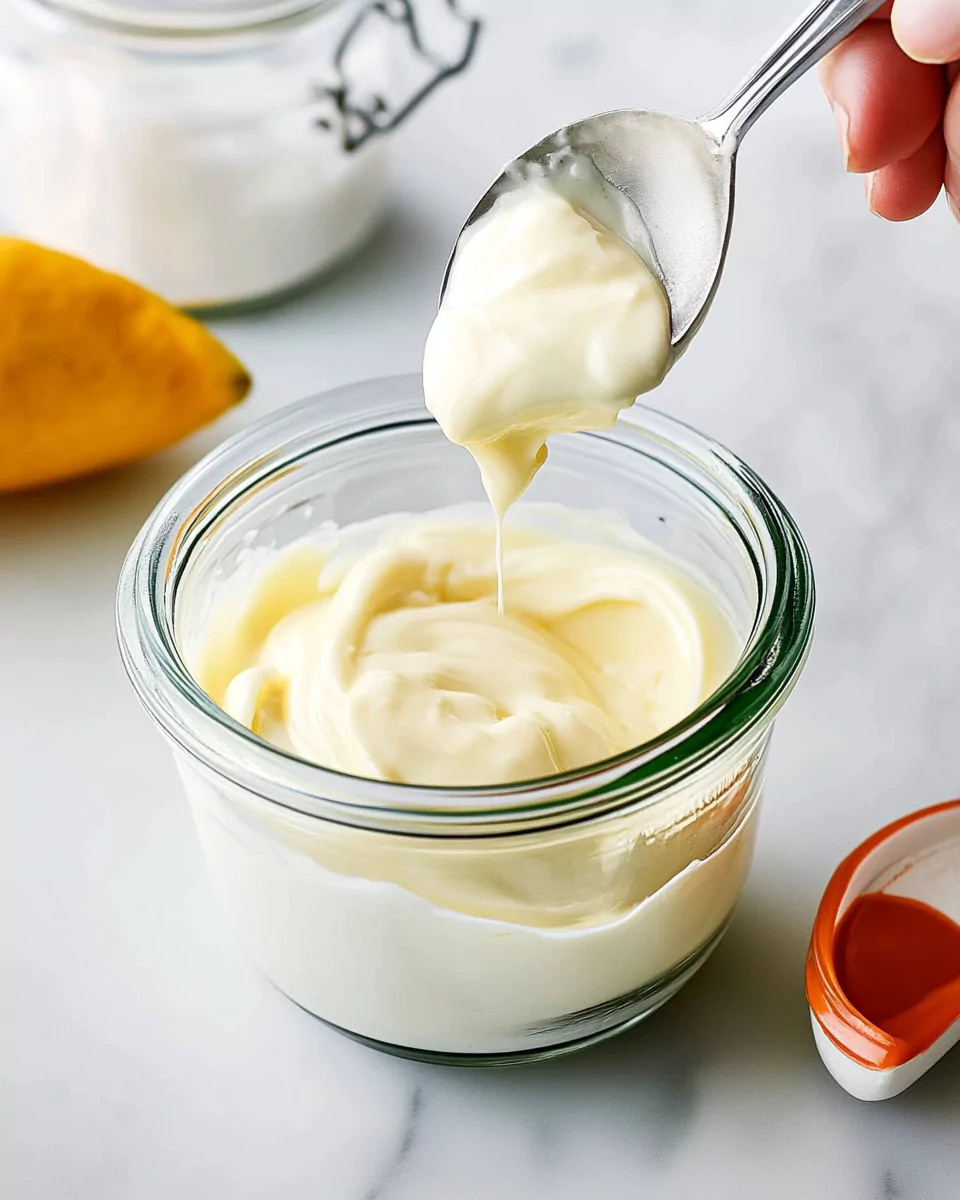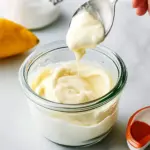Making mayonnaise at home is incredibly quick, simple, and satisfying! This foolproof recipe comes together in less than one minute using a stick blender and everyday pantry ingredients. Whether you’re a culinary enthusiast or looking for a healthier alternative to store-bought options, this recipe is sure to become a staple in your kitchen.

Why You’ll Love This Recipe
- Quick & Easy: Ready in under a minute!
- Minimal Ingredients: Uses simple pantry staples.
- Customizable: Adjust flavors to suit your preferences.
- Healthier Option: Free from preservatives or artificial ingredients.
- Versatile Use: Perfect for sandwiches, dressings, and dips.
Preparation Phase & Tools
Essential Tools and Equipment
- Stick Blender: Ensures proper emulsification.
- Blender Jar: Ideal for blending small batches.
- Airtight Container: For storage.
Importance of Each Tool
- Stick Blender: Creates the right texture and prevents splitting.
- Blender Jar: Helps contain the ingredients for smooth blending.
Preparation Tips
- Oil Choice: Use avocado oil or light-flavored olive oil for a neutral, smooth taste.
- Egg Quality: Use fresh eggs for the best results and food safety.
- Room Temperature Ingredients: This improves emulsification.
Ingredients
- 1 whole egg
- ½ tablespoon lemon juice
- 1 teaspoon white wine vinegar
- ¼ teaspoon Dijon mustard
- ¼ teaspoon sea salt
- 1 cup avocado oil (or light-flavored olive oil)
Step-by-Step Instructions
1. Combine Ingredients
- Add the egg, lemon juice, vinegar, mustard, and salt into the jar provided with your immersion blender.
- Slowly pour the oil on top, allowing it to settle for about one minute.
2. Start Blending
- Place the stick blender at the bottom of the jar.
- Press firmly against the bottom, covering the egg yolk. Turn the blender on and keep it stationary for 10–15 seconds as the mixture thickens.
3. Finish Blending
- Once emulsification begins, slowly move the blender up and down to fully mix all ingredients.
4. Store
- Transfer the mayonnaise to an airtight container and refrigerate for up to one week.
Serving Suggestions
Homemade mayonnaise is versatile and elevates countless dishes. Here are some delicious ways to use it:
- Sandwiches & Burgers
- Spread a generous layer on your favorite sandwiches or burgers for added creaminess.
- Pair it with deli meats, cheese, or vegetarian fillings for a gourmet touch.
- Salad Dressings
- Use it as a base for creamy dressings like ranch, Caesar, or coleslaw dressing.
- Mix with fresh herbs, garlic, or lemon juice for a tangy salad topping.
- Dips & Spreads
- Perfect as a dip for fries, veggie sticks, or chips.
- Combine with sriracha or garlic for a quick, flavorful aioli.
- Marinades
- Add richness to chicken, fish, or vegetable marinades with a spoonful of mayo.
- Potato & Pasta Salads
- Toss with boiled potatoes or cooked pasta for a creamy, satisfying salad.
- Deviled Eggs
- Use it as the filling base for classic deviled eggs or creative variations.
- Grilled Veggies
- Serve as a side dip for roasted or grilled vegetables like asparagus, zucchini, or bell peppers.
- Seafood Companion
- Pair with crab cakes, shrimp, or lobster rolls for an indulgent experience.
Common Mistakes to Avoid
Making mayonnaise at home is straightforward, but a few mistakes can lead to failure. Here’s how to avoid common pitfalls:
1. Moving the Blender Too Early
- Mistake: Lifting or moving the blender before emulsification begins.
- Fix: Keep the stick blender stationary at the bottom of the jar for 10–15 seconds until the mixture starts to thicken.
2. Using the Wrong Oil
- Mistake: Using strongly flavored oils like extra virgin olive oil, which overpowers the mayonnaise.
- Fix: Stick to neutral oils like avocado oil or light-flavored olive oil for the best taste.
3. Skipping Room Temperature Ingredients
- Mistake: Using cold ingredients, which can prevent proper emulsification.
- Fix: Let all ingredients come to room temperature before blending.
4. Adding Oil Too Quickly (if Using a Food Processor)
- Mistake: Pouring oil too fast, causing the emulsion to break.
- Fix: Slowly drizzle the oil for a stable mixture.
5. Not Using Fresh Ingredients
- Mistake: Using old eggs or stale vinegar, compromising flavor and safety.
- Fix: Always use the freshest eggs and high-quality vinegar for optimal results.
Side Dish Recommendations
Pair your homemade mayonnaise with these delightful sides to create a complete meal:
- Classic French Fries
- Serve with hot, crispy fries for the ultimate comfort food.
- Sweet Potato Fries
- A healthier, slightly sweet alternative to classic fries.
- Grilled Corn on the Cob
- Slather mayonnaise on corn and sprinkle with cheese and spices for Mexican-style elote.
- Veggie Platter
- Offer a mix of carrot sticks, celery, bell peppers, and cherry tomatoes for dipping.
- Fried Chicken Tenders
- Use as a dip for crunchy, golden-brown chicken strips.
- Roasted Baby Potatoes
- Toss with mayo-based dips for a creamy, savory touch.
- Coleslaw
- Mix with shredded cabbage and carrots for a fresh, tangy slaw.
- Seafood Platter
- Complement shrimp, crab, or fish sticks with a dollop of creamy mayonnaise.
Recipe Tips for Success
1. Customize the Flavor
Enhance your mayonnaise by experimenting with these additions:
- Garlic Mayo: Add a small clove of minced garlic.
- Spicy Mayo: Mix in a dash of sriracha or hot sauce.
- Herb-Infused: Blend in fresh herbs like parsley, dill, or basil.
- Zesty Citrus: Add a splash of lime or orange juice for a tangy twist.
2. Perfect the Emulsification
- If the mayo doesn’t thicken, add another egg yolk and blend again.
- Always pour the oil slowly if using a food processor or whisk.
3. Batch Adjustments
- Halve the recipe for a smaller batch or double it for a larger yield.
- Maintain the ingredient proportions for consistent results.
Storage and Reheating Instructions
Storage
- Refrigeration: Transfer mayonnaise to an airtight container. Store in the fridge for up to 1 week.
- Labeling: Note the preparation date to ensure freshness.
Reheating
- Mayonnaise doesn’t require reheating. For cold dishes, remove it from the fridge a few minutes before serving.
Freezing
- Not recommended, as freezing breaks the emulsion and alters the texture.
FAQs
1. Can I make mayonnaise without a stick blender?
Yes! You can use a food processor or whisk, but it will take longer. With a whisk, add the oil very slowly while whisking continuously.
2. Is it safe to use raw eggs?
Using the freshest eggs reduces the risk of contamination. You can also use pasteurized eggs for added safety.
3. What is the best oil for homemade mayonnaise?
Neutral oils like avocado oil or light-flavored olive oil work best. Avoid strongly flavored oils like extra virgin olive oil.
4. Can I fix broken mayonnaise?
Yes! Add a fresh egg yolk to a clean bowl and slowly whisk in the broken mayonnaise until it emulsifies again.
5. How can I make vegan mayonnaise?
Replace the egg with aquafaba (chickpea brine) and use a plant-based milk for creaminess.
6. Why is my mayonnaise too thin?
This could result from not blending long enough or the wrong oil-to-egg ratio. Blend longer or add an additional egg yolk.
7. Can I use mayonnaise in baking?
Yes! It’s an excellent ingredient for moist cakes and bread.
8. What’s the difference between store-bought and homemade mayonnaise?
Homemade mayonnaise is fresher, free from preservatives, and fully customizable to your taste.
Conclusion
Making homemade mayonnaise is quick, simple, and incredibly rewarding. It’s healthier, more flavorful, and free of additives compared to store-bought options. Whether you’re whipping up a sandwich spread, a salad dressing, or a dip, this recipe delivers unbeatable freshness and taste.
Don’t hesitate to customize it with herbs, spices, or citrus to create your own signature mayo. Once you try making mayonnaise at home, you’ll never want to go back to store-bought!
Easy Homemade Mayonnaise
Ingredients
- 1 whole egg
- ½ tablespoon lemon juice
- 1 teaspoon white wine vinegar
- ¼ teaspoon Dijon mustard
- ¼ teaspoon sea salt
- 1 cup avocado oil or light-flavored olive oil
Instructions
Combine Ingredients:
- Add the egg, lemon juice, vinegar, mustard, and salt to the jar that came with your immersion blender. Slowly pour the oil on top of the ingredients, allowing it to settle for about one minute.
Start Blending:
- Place the immersion blender into the jar, ensuring it is pressed firmly against the bottom and covers the egg yolk. Turn the blender on and keep it stationary at the bottom of the jar for 10-15 seconds as the mixture begins to emulsify and thicken.
Finish Blending:
- Once the mayonnaise starts to emulsify, slowly move the blender up and down to fully incorporate all the ingredients.
Store:
- Transfer the mayonnaise to an airtight storage container and refrigerate.
Lisa’s Tips
- Stick Blender: A stick blender works best for this recipe and ensures proper emulsification.
- Video Tutorial: Watch the video for step-by-step guidance.
Notes
Use Fresh Eggs: Because this recipe uses raw egg, ensure you’re using the freshest eggs possible and keep the mayonnaise refrigerated.
Serving Ideas: Use this homemade mayonnaise for sandwiches, dressings, or as a dip.




Leave a Comment